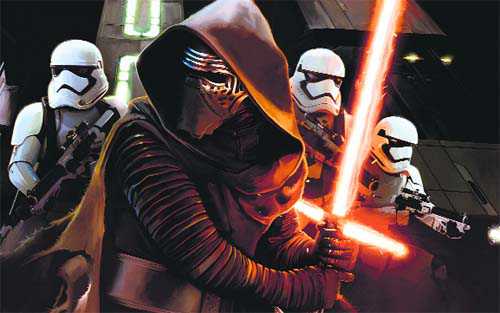Regardless of whether you are a diehard fan of Star Wars or someone who confuses it with the similar-sounding television series Star Trek, there is a heavy possibility that you will come across something related to the famous Hollywood franchise sooner or later — even if it means Narendra Modi quoting a line from the movie.
Go ahead, open your son’s treasure box of video games, or look for those pop-culture-stamped tazos of Star Wars, once found in a popular pack of potato chips during the ’90s! And, if the above-mentioned references don’t quite ring a bell, the viral video of Modi (captured during his first visit to the US as the PM in 2014) saying ‘may the force be with you’ quote from the movie, certainly will.
Figure it out!
Wondering what makes this film a cult?
Maybe, it’s the age-old ‘good versus bad’ plot treated on a whole new ‘inter-galactic space’ dimension created by George Lucas way back in 1977, or the way the story relates with economic, political, emotional and even spiritual aspects — on the individual and social level. The fact that Star Wars holds the ground as one of the most progressive films of its time solely merits its worth. “It was quite a revolutionary film and was way ahead of its time. But that’s not just where it ends; Star Wars was released during the Cold War and its title, A New Hope, evoked a sense of optimism in those days of negativity and phobia of the Soviet Union,” says Devinder S Mahal, a restaurateur, who went to watch the May 4 premiere of the first Star Wars in New York. “I remember them giving out pins that read ‘may the force be with you’; I still have the one I bought. They went big with merchandise — action figures, lunchboxes, and pencil-boxes among others,” he remembers. Perhaps, the reason why PM Modi quoted a line from the movie is that Star Wars is religion to many in the world, just like cricket in India. The movie gave the UK a new religion during the country’s 2001 national census. As a mark of protest against religious profiling, 3.3 lakh people wrote their religion as ‘Jedi Knights’ during the government exercise. “In the movie, Jedis are superhero-like warriors/rebels who fight against injustice and are protectors of the oppressed,” says Christine Mahal, a Star Wars fan.
The newfound religion ran out of steam by the time the UK carried out its 2012 census. This time, 1.73 lakh submitted their religion as ‘Jedi Knights’. Three years on, there was an online petition by students of a Turkish university demanding a ‘Jedi temple’ on their campus, but not much came of it.
Pop culture
Right from video games to television, the film has found mention in many spheres of pop culture. The first video game, an unlicensed flying game by Apple Computers, was released on Apple II in 1978. Officially, the first licensed game, Star Wars Electronic Battle Command, hit US stores in 1979.
However, it was only after the 1999 release of Star Wars I: that a series of video games woven around the franchise was released. For music producer Ranbeer Sidhu, it is the fantasy world of Star Wars, and the detail with which it has been made. “They’re masterpieces of the virtual sort; the graphics, details, and play on the movie franchise’s narrative is detailed and reflects the assiduous writing gone into it over the 38 years that it has existed,” he says.
In television, the animated series Star Wars: Clone Wars has aired on Cartoon Network in the US since 2008. Bollywood film director and Star Wars geek Mahesh Nair, who himself saw the first movie at a cinema hall in Mumbai in 1977, offers a rather different picture of what has influenced what. “Though Star Wars influenced many aspects of pop culture, it itself seems to have been inspired by the television series Star Trek, which first aired on NBC for three seasons from 1966. Like the movie franchise, it was also set in an inter-galactic fantasy world,” he says. Besides, Star Wars also influenced the architecture, be it Lucasfilm HQ at Singapore and its striking resemblance with ‘Jawa Sandcrawler’ or Casa da Música by Rem Koolhaas in Portugal, where the building’s angular yet extensive facade makes it look quite like the Sandcrawler.
India connect
Though the first trilogy of the movie — comprising Episodes IV, V and VI — ended up becoming world-famous, it truly came to India in 1999, when the first prequel was marketed in a big way on television and in media. A famous brand of potato chips offered merchandise as freebies, while cartoon-based television channels bombarded wide-eyed, school-going children with advertisements. With Star Wars Episode II: Attack of the Clones (2002) and Star Wars Episode III: Revenge of the Sith (2005) being released in a quick succession, the movie gained popularity fast.
With commercial events such as Comic Con starting in Delhi, Mumbai and Bangalore, the ‘Star Wars’ phenomenon has only got bigger. At the recently concluded Delhi Comic Con, Lucasfilms — the company owned by Star Wars creator George Lucas and which has released the seventh and latest movie of the franchise on December 18 — went big on promotions. “Finally, it feels that Star Wars has actually arrived in India,” says Mansi Sharma, one of the organizers of Comic Con Delhi.
Unlock Exclusive Insights with The Tribune Premium
Take your experience further with Premium access.
Thought-provoking Opinions, Expert Analysis, In-depth Insights and other Member Only Benefits
Already a Member? Sign In Now










